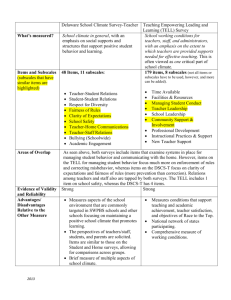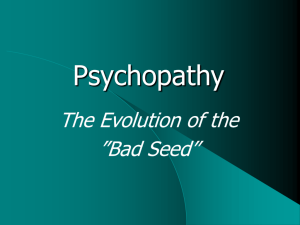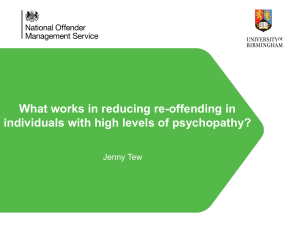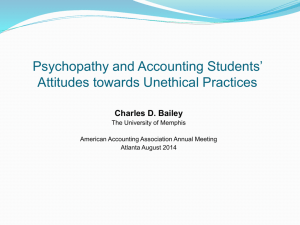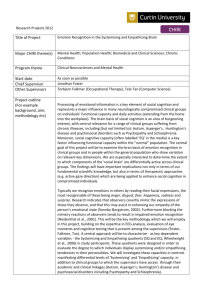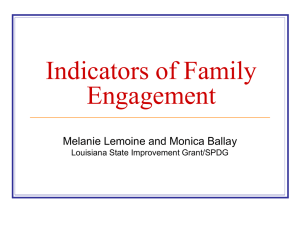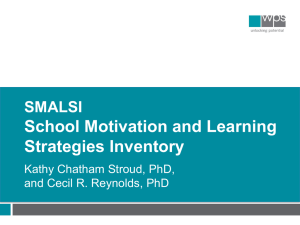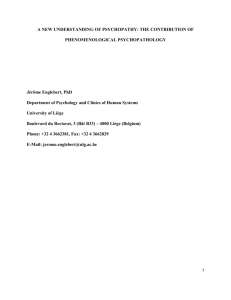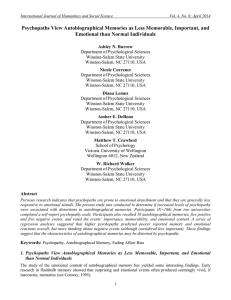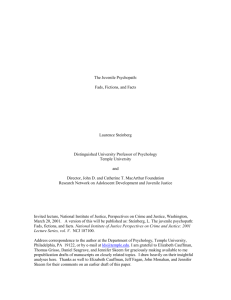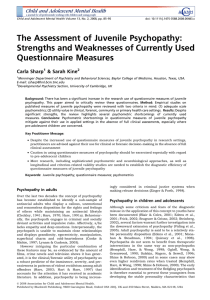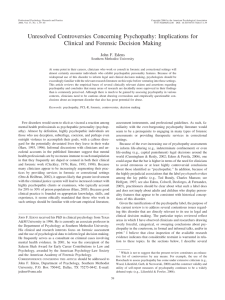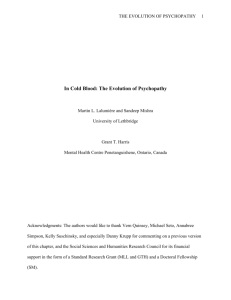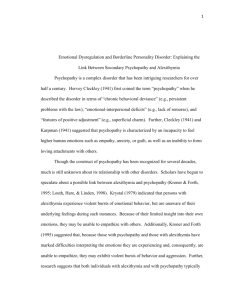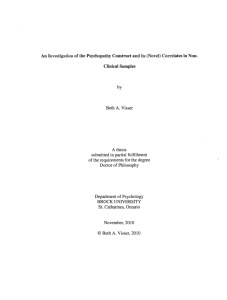PAS-PAS2-Drislane20121652-RR
advertisement
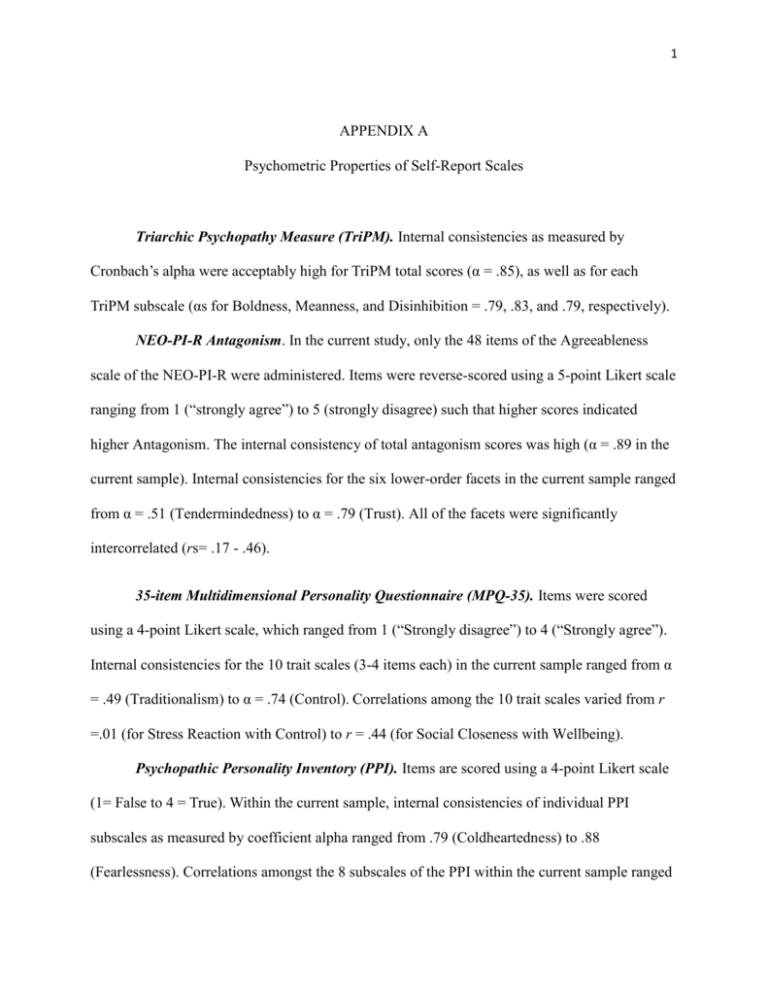
1 APPENDIX A Psychometric Properties of Self-Report Scales Triarchic Psychopathy Measure (TriPM). Internal consistencies as measured by Cronbach’s alpha were acceptably high for TriPM total scores (α = .85), as well as for each TriPM subscale (αs for Boldness, Meanness, and Disinhibition = .79, .83, and .79, respectively). NEO-PI-R Antagonism. In the current study, only the 48 items of the Agreeableness scale of the NEO-PI-R were administered. Items were reverse-scored using a 5-point Likert scale ranging from 1 (“strongly agree”) to 5 (strongly disagree) such that higher scores indicated higher Antagonism. The internal consistency of total antagonism scores was high (α = .89 in the current sample). Internal consistencies for the six lower-order facets in the current sample ranged from α = .51 (Tendermindedness) to α = .79 (Trust). All of the facets were significantly intercorrelated (rs= .17 - .46). 35-item Multidimensional Personality Questionnaire (MPQ-35). Items were scored using a 4-point Likert scale, which ranged from 1 (“Strongly disagree”) to 4 (“Strongly agree”). Internal consistencies for the 10 trait scales (3-4 items each) in the current sample ranged from α = .49 (Traditionalism) to α = .74 (Control). Correlations among the 10 trait scales varied from r =.01 (for Stress Reaction with Control) to r = .44 (for Social Closeness with Wellbeing). Psychopathic Personality Inventory (PPI). Items are scored using a 4-point Likert scale (1= False to 4 = True). Within the current sample, internal consistencies of individual PPI subscales as measured by coefficient alpha ranged from .79 (Coldheartedness) to .88 (Fearlessness). Correlations amongst the 8 subscales of the PPI within the current sample ranged 2 from r = -.02 (for Stress Immunity with Machiavellian Egocentricity) to r = .50 (for Fearlessness with Impulsive Nonconformity). Self-Report Psychopathy Scale-III (SRP-III). Items are scored using a 5-point Likert scale ranging from 1 (disagree strongly) to 5 (agree strongly). Within the current sample, internal consistency of the SRP-III total psychopathy score was high (α = .93), with coefficient alpha ranging from .76-.86 for SRP-III subscales (Callous Affectα = .76; Interpersonal Manipulation α = .86; Erratic Lifestyle α = .84; and Criminal Tendencies α = .82). The subscales of the SRP-III were moderately to highly intercorrelated in the present sample, ranging from r = .43 (for Erratic Lifestyle with Criminal Tendencies) to r = .63 (for Callous Affect with Interpersonal Manipulation). Levenson's Self-Report Psychopathy Scale (LSRP). Items are scored using a 5-point Likert scale ranging from 1 (Strongly Disagree) to 5 (Strongly Agree). Internal consistency for the LSRP total score was .84, whereas coefficient alphas was somewhat lower for the Primary (α = .83) and Secondary (α = .68) subscales. In the present sample, the LSRP Primary and Secondary scales were moderately correlated (r = .42). Youth Psychopathic Traits Inventory (YPI). Items are scored using a 4-point Likert scale, ranging from 1 (“does not apply at all”) to 4 (“applies very well”). Internal consistency for overall psychopathy scores on the YPI was very high (α = .93 in the current sample). Internal consistency reliabilities for the Grandiose-Manipulative, Callous-Unemotional, and ImpulsiveIrresponsible broad factors in the current sample were high (αs= .90, .85, and .82, respectively), with reliabilities for the 10 subscales also acceptable (α range = .66 to .83). The three factors were moderately intercorrelated (rs = .39 - .58). 3 Child Psychopathy Scale (CPS). Participants are instructed to indicate the degree to which items are true of them by responding either No (0) or Yes (1). Responses on the CPS yield a total psychopathy score (α = .80 in the current sample) and scores on 13 subscales, each composed of 2 to 7 items. Within the current study sample, the internal consistency of the CPS subscales ranged from α = .27 (Lack of Guilt; 3 items) to α = .74 (Behavioral Dyscontrol; 3 items). Correlations among the 13 CPS subscales in the current sample ranged from r = -.05 (for Lack of Guilt with Behavioral Dyscontrol) to r = .56 (for Unreliability with Parasitic Lifestyle). Antisocial Process Screening Device (APSD). Items are scored using a 3-point Likert scale ranging from 0 (“not true at all”) to 2 (“definitely true”). Responses on the APSD selfreport measure yield a total psychopathy score (α = .78 in the current sample) and scores on two Factors, Callous/Unemotionality (CU; α = .51) and Impulsivity/Conduct Problems (I/CP), with the latter divisible into Narcissism (α = .67) and Impulsivity (α = .62) subfactors. Within the current study sample, correlations amongst the 3 component dimensions of the APSD varied from r = .23 (for Callous-Unemotionality with Impulsivity) to r = .37 (for Impulsivity with Narcissism). Inventory of Callous-Unemotional Traits (ICU). Items are scored using a 4-point Likert scale ranging from 0 (“not at all true”) to 3 (“definitely true”). In the current study sample, the internal consistency for ICU total scores was .84, with coefficient alphas somewhat lower for the four facet scores: Careless (α = .75), Unemotional (α = .82), Callous (α = .53), and Uncaring (α = .71). Correlations amongst the 4 facets of the ICU in the current sample varied from r = .11 (for Careless with Unemotional) to r = .60 (for Callous with Uncaring). 4 APPENDIX B Descriptive Statistics Triarchic Psychopathy Measure TriPM Total Boldness Meanness Disinhibition NEO-PI-R Antagonism Antagonism Total Score (lack of) Trust (lack of) Straightforwardness (lack of) Altruism (lack of) Compliance (lack of) Modesty (lack of) Tendermindedness Multidimensional Personality Questionnaire (35-item) Social Potency Wellbeing Stress Reaction Achievement Harm Avoidance Social Closeness Aggression Alienation Control Traditionalism Psychopathic Personality Inventory PPI Total Score PPI-FD Social Potency Fearlessness Stress Immunity PPI-IA Machiavellian Egocentricity Impulsive Nonconformity Alienation Carefree Nonplanfulness Coldheartedness Self-Report Psychopathy Scale-III Mean SD 120.10 52.70 32.19 35.13 15.67 7.56 7.87 7.44 121.66 21.16 20.06 15.61 22.87 21.70 20.27 19.16 5.27 4.88 4.27 4.95 4.89 3.81 9.40 5.25 7.80 7.57 4.72 7.23 12.88 9.33 5.35 7.74 2.46 1.80 2.41 2.26 1.75 2.64 2.67 2.00 1.83 1.99 318.88 136.09 62.44 46.38 29.71 143.97 63.62 10.95 35.41 36.42 43.62 57.11 25.03 10.92 10.93 5.99 26.83 12.04 2.83 8.97 7.17 8.21 5 SRP-III Total Score Interpersonal Manipulation Callous Affect Erratic Life Style Criminal Tendencies Levenson Self-Report Psychopathy Scale LSRP Total Primary Secondary Youth Psychopathic Traits Inventory YPI Total Grandiose Manipulation Factor Dishonest Charm Grandiosity Lying Manipulation Callous/Unemotional Factor Callousness Remorselessness Unemotionality Impulsive/Irresponsible Factor Thrill-Seeking Impulsiveness Irresponsibility Child Psychopathy Scale CPS Total Score Glibness Lack of Guilt Poverty of Affect Manipulation Callousness Untruthfulness Parasitic Lifestyle Behavioral Dyscontrol Unreliability Failure to Accept Responsibility Lack of Planning Impulsiveness Boredom Susceptibility Antisocial Process Screening Device APSD Total Score 143.02 39.56 38.02 42.50 23.76 29.88 9.74 7.99 10.24 8.31 59.20 29.82 19.17 6.53 7.01 4.27 102.49 40.11 10.86 10.49 9.15 9.84 29.27 9.46 8.97 10.88 33.33 13.38 10.95 9.02 19.97 9.93 3.25 2.72 3.02 3.16 6.94 2.67 2.72 2.87 6.81 2.76 2.83 2.93 85.62 6.27 5.06 12.15 5.19 7.48 8.45 7.46 4.65 5.71 5.13 5.60 5.10 7.78 10.06 1.23 0.70 1.47 0.95 0.94 1.36 0.92 1.23 0.69 0.88 0.74 0.79 1.54 31.01 5.11 6 Narcissism Callous-Unemotionality Impulsivity Inventory of Callous-Unemotional Traits ICU Total Score Unemotional Callous Uncaring 10.49 8.78 8.67 2.27 1.79 1.95 43.23 12.03 12.19 14.85 8.43 3.48 3.54 3.79
